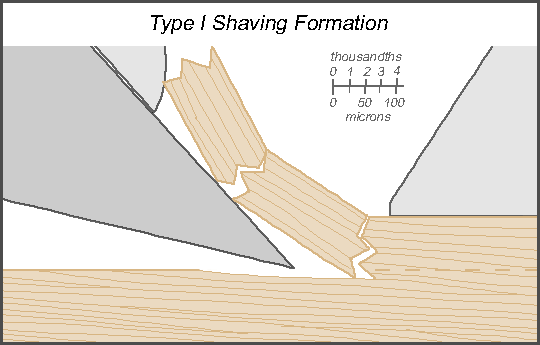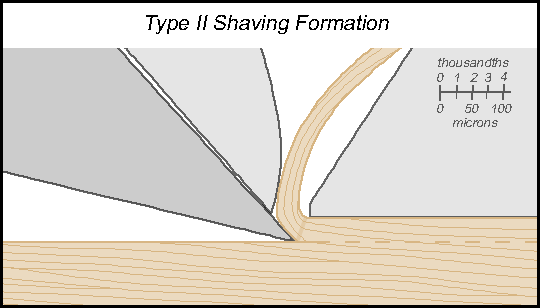|
|
|
The way in which a sharp blade interacts with wood to form a chip or shaving is classified using a system developed in the 1950s by Norman Franz for his doctoral thesis on machining wood. Dr. Franz described chip Types I to III. Later research by William McKenzie described an additional Type 0 chip. The only account I have been able to find of their research is in Appendix I of Leonard Lee’s book The Complete Guide to Sharpening. The description below is based on that account and on information from Bruce Hoadley’s book Understanding Wood, both of which I recommend highly. Additional information comes from a similar study by Chutaro Kato of Yamagata University, who used a video camera to study the effects of chipbreakers. Professor Kato used a cutting angle of 40º, which is much lower than the angles studied by Dr. Franz and is more typical of hand planes used on softwoods. My description of the mechanics of shaving formation is somewhat speculative, particularly regarding the unbroken nature of the fibers in a Type 0 chip and the shearing effect of bending in a Type II chip. In the following description, the terms chip and shaving are used to mean the same thing. Chips are typical of power machinery that uses rotary cutters, and shavings are typical of hand tools with blades that travel in straight lines. The mechanisms of chip formation are the same for both types of tool. Chip Classification by Type Type 0: When a very sharp blade at a low angle to the workpiece is cutting with the grain, a shaving can be taken in which the fibers of the wood have not been bent significantly. (Think of a paring chisel with a bevel angle of 20º being used to cut softwood.) Unlike the other types of shaving, Type 0 has fibers that have not been broken as in Type I or been forced to slide relative to each other (sheared) as in Type II. When planing softwood with the grain, a Type 0 chip will be likely to produce a surface on the wood that has maximum clarity and an appearance of depth.
Type I: When a thick shaving is taken by a blade with a greater angle to the workpiece, the wood tends to split ahead of the blade. When planing with the grain, the split wood is removed and becomes part of the shaving. When planing against the grain, the splitting causes chunks of wood to be removed below the cutting line, leaving defects in the surface that are known as tear-out. Type I chip formation is a cyclical process in which the splitting increases until the shaving breaks, and then begins again. The shaving produced is segmented due to its broken nature.
Type II: When a thin shaving is taken or the angle of the blade is increased relative to the workpiece, a different mechanism of chip formation can occur in which the wood is cut right at the sharp edge of the blade and is then forced to bend sharply. This forces the fibers in the wood to slide against each other inducing a “shearing” effect that causes the shaving to lose much of its stiffness and reduces the chance that the wood will split ahead of the blade edge. A Type II shaving is curly but not segmented. In the images made by Dr. Franz, the line where this shearing starts is clearly visible.
Type III: If the angle of the blade relative to the workpiece is increased further, a different mechanism for chip formation can occur. This is a scraping action, in which the wood is sheared off right at the cutting edge of the blade. Because of the high angle of the blade, significant forces are created that can deform the wood below the cutting line. Type III cutting is more effective on hard woods than soft ones because of the damage done to soft wood by this deformation. From my experience in trying to produce Types I and II, I believe the overwhelming majority of shavings taken by smoothing planes are of Type II. For an account of my attempt to produce a Type I shaving, click here. The Cutting Action of Smoothing Planes While the discussion below is speculative, it is based on close examination of the shavings taken and the wood surfaces produced by a variety of planes. My description of the mechanics of shaving formation is intended to explain the following observations:
Most descriptions of the cutting action of hand planes suggest that Type I cutting is typical. This may be true for carpenter's planes, but for smoothers I believe Type II is far more common. The reason is shaving thickness. The thinner a shaving is, the less likely that it will break in the Type I manner. [click for supporting evidence] Areas of tear-out are clearly the result of Type I behavior, and my current thinking is that to avoid tear-out the chipbreaker setting and the mouth gap can be optimized in a way that will help keep the cutting action from changing to Type I from Type II. This is pure speculation on my part, since I don't have the equipment to take photomicrographs of shaving formation like the ones in Leonard Lee's book The Complete Guide to Sharpening. But I've been studying those images and the ones from Chutaro Kato's investigation of chipbreakers, and so far the results of their work seem consistent with my idea. The excellent results possible from a plane with a mouth dimension of 3 thousandths are an argument in support of my view, at least in my opinion. I've never been able to get zero tear-out when planing difficult grain, and I'm sure the reason is that the smallest mouth gap I've used is 8 thousandths. Using the Type I model, a mouth gap of that size would reduce tear-out to 8 thousandths or less in length, with depth depending on the steepness of the grain direction. I believe that when the mouth gap is made especially small, the pressure on the wood just in front of the blade edge will keep the cutting action from switching to Type I at all, so that tear-out is avoided altogether instead of just being reduced to 3 thousandths. Again, this is just speculation but I hope it's true. The high-quality surface prized by the Japanese on softwood (which I sometimes refer to as having the appearance of depth) results from more than just eliminating tear-out. With soft woods the pressure exerted on the wood by the blade edge as it cuts can deform the surrounding wood both ahead of the blade edge and below the cut line. When this deformed wood returns to its original shape, it has been bruised in a way that causes the surface to have a cloudy look. Producing that deep-appearing surface depends on reducing the amount of force the cutting edge applies to the wood as it cuts. Two factors are involved here: blade sharpness and cutting angle. An extremely sharp blade cutting at a low angle will reduce the deformation to a point where the wood on the planed surface is undamaged rather than bruised. Japanese planes used on softwoods are of just this type, having unusually low cutting angles. Note that this description doesn't mention shaving type. I don't know for sure what the shaving type would be here, although the one description I have of a Type 0 shaving refers to its being created by "a very sharp blade with a very low cutting angle cutting with (or exactly parallel to) the grain." (Lee, p. 233). I haven't done any work yet trying to produce this type of surface, I've just noticed the cloudy look I get when I use a Norris on Douglas fir. I'll need some low angle planes if I want to experiment with this. Since I'm using back bevels for all my sharpening, the bed angle of the plane would have to be especially low.
Supporting Evidence Effect of shaving thickness on shaving type: One of the photos in Leonard Lee’s book on sharpening shows Type I and II chips being formed “in combination.” (Lee, The Complete Guide to Sharpening, p. 231, middle image) The original shaving thickness of about .006” produces a Type I chip that causes the wood to split ahead of the blade. This leaves a much thinner amount of wood to be cut by the blade, resulting in a brief period of Type II cutting until the shaving thickness again reaches the point where the cutting action returns to Type I. The segments of shaving in the photo show a curly portion of Type II shaving that changes to a straight Type I portion about one third of the way back from the front of the segment. This suggests that for the species being planed, Type II cutting occurs in shavings less than .002” thick. The same results are seen in the study of chipbreakers by Chutaro Kato. Figures 5 and 6 show a blade cutting against the grain, with a shaving .004” thick resulting in Type I cutting and a shaving .002” thick resulting in Type II. My own efforts to produce a Type I shaving were successful only when the shaving thickness reached .009 inches.
|
|
[Home] [Summary of Results] [Testing Procedure] [Chipbreaking] [Cutting Angles] [Shaving Formation] [Making Shavings] [Tuning Infill Planes] [Links & References] [Contact] [Site Map] |

